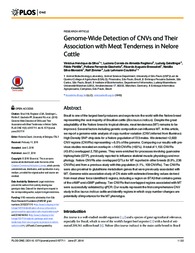Genome-wide detection of CNVs and their association with meat tenderness in Nelore cattle.
Genome-wide detection of CNVs and their association with meat tenderness in Nelore cattle.
Author(s): SILVA, V. H. da; REGITANO, L. C. de A.; GEISTLINGER, L.; PÉRTILLE, F.; GIACHETTO, P. F.; BRASSALOTI, R. A.; MOROSINI, N. S.; ZIMMER, R.; COUTINHO, L. L.
Summary: Brazil is one of the largest beef producers and exporters in the world with the Nelore breed representing the vast majority of Brazilian cattle (Bos taurus indicus). Despite the great adaptability of the Nelore breed to tropical climate, meat tenderness (MT) remains to be improved. Several factors including genetic composition can influence MT. In this article, we report a genome-wide analysis of copy number variation (CNV) inferred from Illumina1 High Density SNP-chip data for a Nelore population of 723 males. We detected >2,600 CNV regions (CNVRs) representing 6.5% of the genome. Comparing our results with previous studies revealed an overlap in 1400 CNVRs (>50%). A total of 1,155 CNVRs (43.6%) overlapped 2,750 genes. They were enriched for processes involving guanosine triphosphate (GTP), previously reported to influence skeletal muscle physiology and morphology. Nelore CNVRs also overlapped QTLs for MT reported in other breeds (8.9%, 236 CNVRs) and from a previous study with this population (4.1%, 109 CNVRs). Two CNVRs were also proximal to glutathione metabolism genes that were previously associated with MT. Genome-wide association study of CN state with estimated breeding values derived from meat shear force identified 6 regions, including a region on BTA3 that contains genes of the cAMP and cGMP pathway. Ten CNVRs that overlapped regions associated with MT were successfully validated by qPCR. Our results represent the first comprehensive CNV study in Bos taurus indicus cattle and identify regions in which copy number changes are potentially of importance for the MT phenotype.
Publication year: 2016
Types of publication: Journal article
Keywords: CNV, Gado Nelore, Genômica, Maciez da carne, Meat tenderness, Nelore
Observation
Some of Embrapa's publications are published as ePub files. To read them, use or download one of the following free software options to your computer or mobile device. Android: Google Play Books; IOS: iBooks; Windows and Linux: Calibre.
Access other publications
Access the Agricultural Research Database (BDPA) to consult Embrapa's full library collection and records.
Visit Embrapa Bookstore to purchase books and other publications sold by Embrapa.

